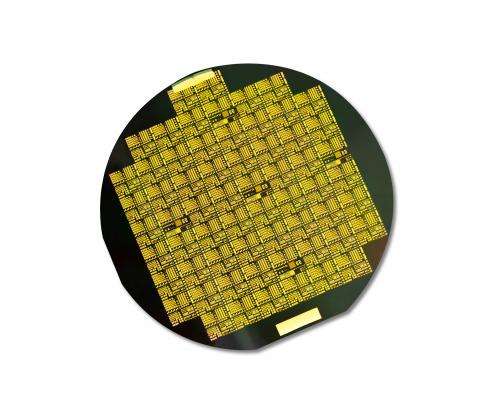New method joins gallium nitride and diamond for better thermal management

Many military radio frequency (RF) systems, like radar and communication systems, use a class of power amplifiers (PAs) called monolithic microwave integrated circuits (MIMIC). MMIC PAs using gallium nitride (GaN) transistors hold great promise for enhanced RF performance, but operational characteristics are strongly affected by thermal resistance. Much of this resistance comes at the thermal junction where the substrate material of the circuit connects to the GaN transistor. If the junction and substrate have poor thermal properties, temperature will rise and performance will decrease.
DARPA's Near Junction Thermal Transport (NJTT) effort recently demonstrated the first-ever GaN-on-diamond high electron mobility transistor (HEMT). In early tests, the GaN-on-diamond transistor displayed substantially lower junction temperatures than comparable commercially available devices. The resulting transistor has dramatically improved thermal properties, which may lead to better performance for RF systems.
"These GaN-on-diamond HEMTs could enable a new generation of RF PAs that are three times smaller than the current state-of-the-art GaN amplifiers" said Avram Bar-Cohen, DARPA program manager. "Smaller amplifiers would lead to RF systems with better size, weight and power characteristics. Alternatively, PAs like these would be able to generate three times as much output power, leading to a stronger signal for communication systems or longer range radar. Almost any RF system could benefit from the combination of higher power, higher efficiency, and reduced size enabled by GaN-on-diamond amplifiers."
In MMIC PAs, the steepest temperature rise occurs in the first few microns below the junction and is directly related to the thermal conductivity of the entire wafer, explained Bar-Cohen. "Providing a high conductivity substrate in intimate contact with the GaN gets us unsurpassed heat tolerance and dissipation capability. We expect this advance will substantially improve the thermally-limited high power RF systems of today."
By using a new epitaxial transfer method, performers at TriQuint Semiconductor were able to remove the GaN from its growth substrate and place it in intimate contact with a synthetically grown and specially prepared diamond substrate. Synthetic diamond has the highest known thermal conductivity of any manmade material, more than 10 times higher than the common semiconductor material, silicon.
NJTT, an effort of DARPA's Thermal Management Technologies (TMT) program, focuses on reducing the thermal resistance of the near-junction region of compound semiconductor devices. Performers in NJTT, which began in 2011, are exploring epitaxial transfer of GaN from silicon and silicon carbide (SiC) to diamond substrates and direct growth of diamond in thermal vias etched in SiC. The goal of TMT is to explore and optimize new nanostructured materials and other recent advances for use in thermal management systems.
Provided by DARPA




















